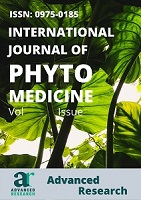Chlorogenic acid-Isolate from White Butterfly (Clerodendrum volubile P. Beauv) Leaf Scavenged Reactive Species and Inhibited α-Glucosidase, α-Amylase, and ACE-1: Pointer to Hypoglycemic and Cardioprotective Potentials
Keywords:
Chlorogenic acid, White butterfly leaf, α-glucosidase, α-amylase, Angiotensin-1 Converting EnzymeAbstract
Chlorogenic acid is bioactive phenolic compound found in medicinal and nutritional plants, linked to several therapeutic relevance, making it a highly commercialized phenolic compound responsible for the economic relevance of the popular green tea. The white butterfly (Clerodendrum volubile P. Beauv) is an indigenous plant whose leaf is blended to make soup among the Ikale and Ijaw tribes, in Ondo State, Nigeria. The aim of this research is to isolate chlorogenic acid from the white butterfly leaf and determine the antioxidant, hypoglycemic and angiotensin-1 converting enzyme (ACE-1) inhibiting potentials as a rider to further studies on the chlorogenic acid fraction. White butterfly leaf was obtained and 80% ethanol was used to extract crude extract, the crude extract was further subjected to chromatographic screening over a 10 g Sephadex LH-20 column to elute fractions using 80 % ethanol as the mobile phase. The crude extract and the chromatographed fraction were characterized using HPLC. The Chromatographed fraction which is the chlorogenic acid isolate of white butterfly leaf (MLECS) was evaluated using biochemical analyses to determine its antioxidant properties, and inhibition of α-glucosidase and α-amylase activities, and ACE-1 activity. The characterization of the polyphenolic compounds revealed the presence of chlorogenic acid as the most predominant compound, while quercetin, ellagic acid, salicylic acid, p-hydroxybenzoic acid, and caffeic acid are in high amount. The chromatogram of the chlorogenic acid fraction showed a single high peak and the purity level of the chlorogenic acid isolate. The chlorogenic acid isolate demonstrated antioxidant properties, inhibited α-glucosidase, α-amylase and ACE-1 activities in a concentration dependent manner with varying IC50 values. The white butterfly leaf is nutritional and therapeutic with respect to the starch hydrolysis and angiotensin-II anabolism. The predominance of chlorogenic acid could increase the economic value as a commercial source of chlorogenic acid.
References
Actis-Goretta, L., Ottaviani, J.I., Keen, C.L., Fraga, C.G., 2013. Inhibition of angiotensin converting enzyme (ACE) activity by flavan-3-ols and procyanidins. FEBS letters, 555:597–600.
Bhalodia, N.R., Nariya, P.B., Acharya, R.N., Shukla, V.J., 2013. In vitro anti-oxidant activity of hydro alcoholic extract from the fruit pulp of Cassia fistula Linn. Ayu., 34, 209–214.
Chan, E.W.C., Lim, Y.Y., Tan, S.P. 2011. Standardised herbal extract of chlorogenic acid from leaves of Etlingera elatior (Zingiberaceae). Pharmacognosy Research. 3:3
Clifford, M.N., 2000. Chlorogenic acids and other cinnamates - nature, occurrence, dietary burden, absorption and metabolism. J Sci Food Agric. 80:1033-43.
dos Santos, M.D., Almeida, M.C., Lopes, N.P., de Souza, G.E.P., 2006. Evaluation of the anti-inflammatory, analgesic and antipyretic activities of the natural polyphenol chlorogenic acid. Biol Pharm Bull. 29:2236-40.
Falusi, V.O., Oluwayomi, S., Imoukhuede, B., Oladipo, G.O., 2021. Alstonia boonei Leaf Mitigated Deleterious Effects of Experimental Type-II-Diabetes-Mellitus against Pancreatic and Neurocognitive Functions. AJRB. 8(2): 19-35
Fang, N., Yu, S., Prior, R.L., 2002. LC/MS/MS characterization of phenolic constituents in dried plums. J Agric Food Chem. 50:3579-85.
Farah, A., Monteiro, M., Donangelo, C., Lafay, S., 2018. Chlorogenic Acids from Green Coffee Extract are Highly Bioavailable in Humans. J. Nutr. 138: 2309–2315.
Halliwell, B., Gutteridge, J.M.C., 1990. Role of free radicals and catalytic metal ions in human disease, An overview. Methods Enzyme molecule. 186:1-85
Leong, L.P. and Shui, G., 2002. An investigation of antioxidant capacity of fruits in Singapore markets. Food Chem.76:65–75.
Matheus, A.S., Tannus, L.R., Cobas, R.A., Palma, C.C., Negrato, C.A., Gomes, M.B., 2013. Impact of diabetes on cardiovascular disease: an update. Int J Hypertens. 653789
Nakatani, N., Kayano, S., Kikuzaki, H., Sumino, K., Katagiri, K., Mitani, T., 2000. Identification, quantitative determination, and antioxidative activities of chlorogenic acid isomers in prune (Prunus domestica L.). J Agric Food Chem. 48:5512-6.
Oboh, G., Agunloye, O.M., Adefegha, S.A., Akinyemi, A.J., Ademiluyi, A.O., 2015. Caffeic and chlorogenic acids inhibit key enzymes linked to type 2 diabetes (in vitro): a comparative study. Journal of Basic and Clinical Physiology and Pharmacology. vol. 26, no. 2, pp. 165–170.
Ogunwa, T.H., Ajiboye, S.A., Sholanke, D.R., Awe, O.B., Ademoye, T.A., Oloye, O.B., Ilesanmi, O.C., 2015. Nutritional evaluation of Clerodendrum volubile (Marugbo) leaves. Asian J. Plant Sci. Res. 5, 26–31.
Ohkawa, H., Ohishi, N. and Yagi, K., 1979. Assay for lipid peroxides in animal tissues by thiobarbituric acid reaction. Anal. Biochem. 95:351–358.
Okaiyeto, K., Falade, A.O., Oguntibeju, O.O., 2021. Traditional Uses, Nutritional and Pharmacological Potentials of Clerodendrum volubile. Plants.10, 1893. https://doi.org/10.3390/plants10091893
Oyaizu, M., 1986. Studies on products of browning reactions: antioxidant activities of products of browning reaction prepared from glucose amine. Jpn. J. Nutr.44:307–315.
Rai, A., Shukla, R., Sawant, S., Shetye, R., Bopte, D., Gavandi, H., 2018. Extraction of Chlorogenic Acid from Green Coffee Beans for Preservation against Bread Spoilage. NCIFEH Conference Proceeding RJLBPCS. 263
Sheikh, J.H., Tsujiyama, M.T., Md Ashabul, I., Rajat, S.B., Hitoshi, A., 2008. Total Phenolic Content, Anti-oxidative, anti- Amylase, Anti-Glucosidase and Anti- Histamine release activities of Bangladeshi fruits. Food Sci Technol Res. 14: 261-68.
Tiwari, A.K., Swapna, M., Ayesha, S.B., Zehra, A., Agawane, S.B., and Madhusudana, K., 2011. Identification of proglycemic and antihyperglycemic activity in antioxidant rich fraction of some common food grains. Int. Food Res. J. 18: 915-923.
Umamaheswari, M., Ajith, M.P., Asokkumar, K., Sivashanmugam, T., Subhadradevi, V., Jagannath, P., Madeswaran, A., 2012. In vitro angiotensin converting enzyme inhibitory and antioxidant activities of seed extract of Apium graveolens Linn. Annals of Biological Research. 3(3):1274-1282
Xiang, Z, Ning, Z., 2008. Scavenging and antioxidant properties of compound derived from chlorogenic acid in South-China honeysuckle. LWT - Food Sci Technol, 41:1189-203.
Zhang, B., Yang, R., Zhao, Y., Liu, C.Z., 2008. Separation of chlorogenic acid from honeysuckle crude extracts by macroporous resins. J Chromatogr B. 867:253-8.
Published
How to Cite
Issue
Section
License
Copyright (c) 2025 Oluwafemi Ibukun, Martha Oladipo, Gideon Oladipo, Emmanuel Olorunfemi, David Ibiyemi, Temitope Elija-Afolabi, Oluwatimilehin Ogunlade

This work is licensed under a Creative Commons Attribution-NonCommercial-NoDerivatives 4.0 International License.


